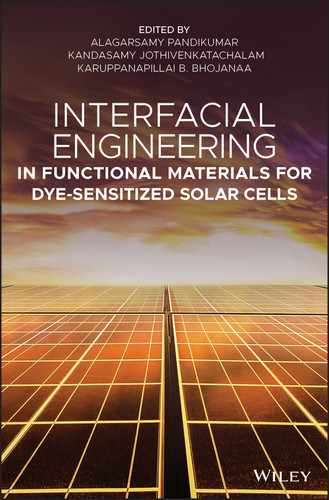Offers an Interdisciplinary approach to the engineering of functional materials for efficient solar cell technology Written by a collection of experts in the field of solar cell technology, this book focuses on the engineering of a variety of functional materials for improving photoanode efficiency of dye-sensitized solar cells (DSSC). The first two chapters describe operation principles of DSSC, charge transfer dynamics, as well as challenges and solutions for improving DSSCs. The remaining chapters focus on interfacial engineering of functional materials at the photoanode surface to create greater output efficiency. Interfacial Engineering in Functional Materials for Dye-Sensitized Solar Cells begins by introducing readers to the history, configuration, components, and working principles of DSSC It then goes on to cover both nanoarchitectures and light scattering materials as photoanode. Function of compact (blocking) layer in the photoanode and of TiCl4 post-treatment in the photoanode are examined at next. Next two chapters look at photoanode function of doped semiconductors and binary semiconductor metal oxides. Other chapters consider nanocomposites, namely, plasmonic nanocomposites, carbon nanotube based nanocomposites, graphene based nanocomposites, and graphite carbon nitride based nanocompositesas photoanodes. The book: Interfacial Engineering in Functional Materials for Dye-Sensitized Solar Cells will be of great benefit to graduate students, researchers and engineers, who work in the multi-disciplinary areas of material science, engineering, physics, and chemistry.
Table of Contents
- Cover
- List of Contributors
- Preface
- 1 Dye‐Sensitized Solar Cells: History, Components, Configuration, and Working Principle
- 2 Function of Photoanode: Charge Transfer Dynamics, Challenges, and Alternative Strategies
- 2.1 Introduction
- 2.2 The General Composition of DSSC
- 2.3 Selection of Substrate for DSSCs
- 2.4 Photoanode
- 2.5 Sensitizer
- 2.6 Charge Transfer Mechanism
- 2.7 Interfaces
- 2.8 Significance of Dye/Metal Oxide Interface
- 2.9 Factors That Influence Efficiency in DSSC
- 2.10 Kinetics of Operation in DSSCs
- 2.11 Strategies to Improve the Photoanode Performance
- 2.12 Conclusion
- Acknowledgments
- References
- 3 Nanoarchitectures as Photoanodes
- 4 Light Scattering Materials as Photoanodes
- 5 Function of Compact (Blocking) Layer in Photoanode
- 6 Function of TiCl4 Posttreatment in Photoanode
- 7 Doped Semiconductor as Photoanode
- 8 Binary Semiconductor Metal Oxide as Photoanodes
- 9 Plasmonic Nanocomposite as Photoanode
- 10 Carbon Nanotubes‐Based Nanocomposite as Photoanode
- 11 Graphene‐Based Nanocomposite as Photoanode
- 12 Graphitic Carbon Nitride Based Nanocomposites as Photoanodes
- 12.1 Introduction
- 12.2 Importance of Graphitic Carbon Nitride
- 12.3 Photoanodes for DSSC
- 12.4 Preparation of Graphitic Carbon Nitride
- 12.5 Operation Principles of DSSC
- 12.6 Graphitic Carbon Nitride in Polymer Films Solar Cell
- 12.7 Preparation of Carbon Nitride Counter Electrode
- 12.8 Quantum Dot Graphitic Carbon Nitride
- 12.9 Porous Graphitic Carbon Nitride
- 12.10 Summary
- Acknowledgment
- References
- Index
- End User License Agreement
